Lomax's History of the Services of the 41st (the Welch) Regiment
Now the 1st Battalion the Welch Regiment
41st Uniform Evolution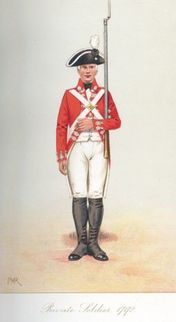
41st Regiment of Foot Private's Uniform (1792)
Uniformed for active service "at home or abroad". The HAT Cocked hats of the private Infantrymen have a white worsted woollen tape binding known as lace. The breadth of the tape was one inch and a quarter with no more to be on the back part of the brim than what was necessary to sew it down. It has a black horsehair cockade secured with a 41st regimental button. This image shows a white feather cockade affixed into the cockade. The hats of the Sergeants and Officers were bound with silver laced. The COAT As of 1787 the 41st Regiment's facings (the colour of their collars and cuffs) were to be red also the coat was made of red madder worsted wool. The men's coats were looped with worsted woollen Regimental lace. The ground of the lace is white, with black stripe (worm) running down the center. The lacing makes a Bastion design "Jew's Harp" loop round the button-hole. Four lace loops on the sleeves and four on the pockets with two on each side of the slit behind. The coat had white metal buttons with a "41" on them. The breadth of all the lapels are three inches and reach down to the waist. The sleeves of the coats have a small round cuff without any slit and are made so that they may be unbuttoned and let down. The cuffs of the sleeve which turns up are three inches and a half deep. The flap on the cross pockets are sewed down. There is a pocket cut in the lining of the coat. The coat had long tails at the rear. The WAISTCOAT (Vest) The waistcoat was made of white wool and are plain without either embroidery or lace. They have no flaps on pockets. The waistcoat comes just below the waist in this time period. The BREECHES The breeches of the private soldier were made from white wool and had a drop front. They came to just below the knees with four regimental buttons fastening them there. The GAITERS The Officers, Sergeants, Corporals, drummers, fifers, and private men all have black linen gaiters with black buttons, small stiff tops and uniform buckles. The gaiters were worn over black leather shoes. The SHOULDER BELTS The breadth of the shoulder belts is two inches and three quarters of white buff tanned leather. The bayonet scabbard belt is attached at the chest by means of a brass breast plate with the Regimental number "41" on it. The ARMAMENT This infantryman is shown with a Short Land, New Pattern Service (Brown Bess) Musket. The standard British infantry arm throughout the entire 18th century was the "land" pattern musket. The long land pattern had a 46" barrel and the short land pattern had a 42" barrel. Both patterns were used by British troops during the American Revolution and continued in use during the War of 1812. This musket was commonly called the "Brown Bess" though scholars continue to disagree as to the origins of this nick-name, the most agreed upon reason is because of the readiness of the musket to rust. 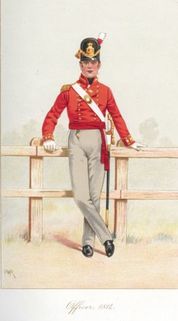
41st Regiment of Foot Officer's Uniform (1814)
2nd Battalion, Late War Regulations The HAT A beaver fur woollen felt Belgic style shako. Adorned with a white over red feather hackle to signify he commands a "Line Company"; if Green it would signify a "Light Company"; and a "white one would be for a "Grenadier Company". The Shako has a gold plated shako plate as well as golden bullion shako cords. The NECK STOCK The officer wears a black silk neckcloth wrapped around the neck twice and then tied somewhat as a bow tie. For formal affairs he would change to a white silk neck cloth. As today, black tie, white tie affair. The COAT The officers had their personal tailors make their uniform coats to regimental specifications out of doe skin or super fine wool. This material today is about $300 a yard. It was also very expensive in the 1800's. This particular 41st Regiment Officer is wearing a new design coat that has short tails and has gold bullion lace (ribbon) around the double breasted button holes and it can be worn as shown or can be folded back and worn with all the lace showing. The early war Regulations for the 41st Regiment of Foot called for silver lace with a black worm (thick thread) running parallel through it centered in the middle of the lace. The uniform is unique to the 41st Regiment. as it has red facings (colour of the collars and cuffs) there were only a couple of regiments in the British Army to have red facings. The SHIRT Most officers in 1812 wore fine linen or silk ruffled shirts as was the fashion for the gentry of the time period. The WAISTCOAT The waistcoat or vest worn by an officer in this time period was usually of silk, fine linen, or doe skin wool. It was single or double breasted and usually has a single pocket. The collar of the vest was the same as the Regimental coat and acted as a liner between the coat and neckcloth. The GLOVES Officers were to wear white kid leather gloves while on duty. During formal affairs they would wear white silk or fine linen gloves. It was very ungentlemanly like to be seen in public without wearing gloves. The TROUSERS These trousers are made of grey doeskin or super fine wool and of the new design having a stripe of golden metallic bullion down the outside seam. They had no pockets save for one to carry his watch in, usually on the right hand side at the coat hem level. The watch fob can be seen hanging from this pocket. The early war specifications called for white breeches or long trousers worn with Hessian styled or gentlemen's riding boots. The SHOES The fashion of wearing low boots known as "Wellingtons" was all the rave in Europe during this time period and the Officers of the British Army adopted them for their dress. Low buckled shoes may also be worn. The SWORD The sword is of the older design as in 1803 a curved bladed sword was allowed to be worn by infantry officers. The sword is worn over the right shoulder on a white buff leather belt that is fastened with a gold plated belt buckle. The buckle or breast plate was cast solid with the number of the regiment on it. 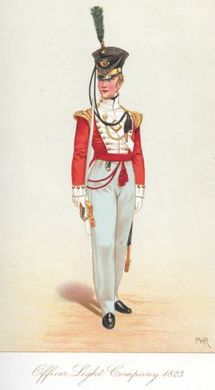
41st Regiment of Foot Officer's Uniform (1823)
Light Company This Officer illustrates the Uniform at the time of the First Burma War, the first large-scale campaign the 41st was involved in after the War of 1812. Some points to note:
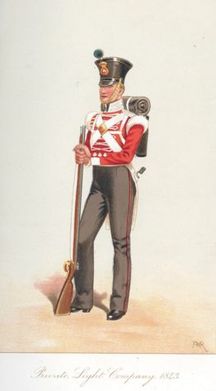
41st Regiment of Foot Private's Uniform (1843)
Light Company This soldier displays the uniform worn by the 41st in Afghanistan in the later stages of the first conflict between British India and that warlike nation. The war had opened with the British occupation of Kabul by a large British force; the subsequent mishandling of the occupation led to a dreadful retreat in the depths of the Afghan winter resulting in the annihilation of the entire British force. The "last stand" of the 44th at Gadamack is the most noteworthy image from that disaster; only one man of the army made it back to the nearest British base. The 41st formed part of the force which, the following campaign season, avenged the defeat of the prior year. The private, of the Light Company, again only has a green pompon on his shako by way of "camouflage". His tunic facings are white, and the distinctive regimental lace of the War of 1812 (white with center black worm) is now just plain white as well. His uniform has been "prettied up" - his shako has an elaborate outer flare to it and his coat has overly-long tails. Not the ideal uniform to campaign in the heat of an arid Afghan summer and into a freezing Afghan winter! His weapon is virtually unchanged from the War of 1812. In fact, he would not look too out of place on a battlefield of that earlier war. At this time period, the 41st had already officially become "The Welch Regiment", though the regimental number was still retained as well. 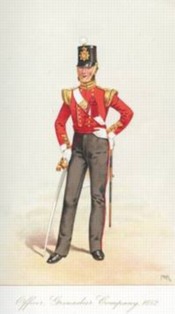
41st Regiment of Foot Officer's Uniform (1852)
Grenadier Company This officer wears the uniform the Regiment went in to the Crimean War utilizing. The exploits of the Regiment at the Alma, in the trenches besieging Sevastopol, and especially in the epic Battle of Inkerman ("the soldier's battle") would attract much public acclaim. Other than a return to a slightly more practical-looking shako (and its white pompon is a main indication that the officer is of the Grenadier company regular line company pompons were lower half red, upper half white, while Light company pompons were green as in the time period of the War of 1812), his uniform is perhaps not greatly changed in style to that of the 1820's. 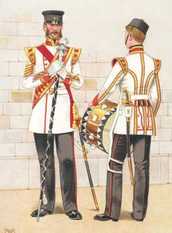
41st Regiment of Foot Drum Major and Drummer (1856)
This duo are shown as they would have appeared at the end of the Crimean War. Regimental custom always demanded that Musicians (who, in battle, would double as stretcher-bearers) have elaborate uniforms, and these two examples are certainly no exception to the rule. Of particular interest is the 41st Regimental Musician's Lace, which, despite the abolishment of regimental-specific lace for the rank and file, remains unique to the 41st, and virtually unchanged from the War of 1812. The lace is red stripes on the outside, followed by yellow stripes that have black spots in them, then white, then a centered black line. Also, the uniform is white faced red, an inversion from the regular red faced white. At the time of the War of 1812, it was of course impossible to "invert" a red uniform faced red, so interestingly, the musician's tunic of the War of 1812 was also white, faced red. Aside from some minor differences in cut and placement of the lace, the 41st musician of 1856 retains a similar overall appearance to his predecessor of the War of 1812. |
41st Regiment of Foot Military Living History Group
Synopsis of Contents Title/Preface Headings of Chapters List of Full Page Illustrations The Narrative: Chapters 1, 2, 3, 4, 5, 6, 7, 8, 9, 10, 11, 12, 13, 14, 15, 16, 17, 18, 19, 20, 21, 22, 23, 24 Mr. Milne's Chapters on the "Dress and Equipment" and "Colours." Appendix Succession List of Colonels Biographies of the Colonels Succession List of Lieutenant-Colonels Biographies of the Lieutenant-Colonels Regimental Plate Pictures Index |